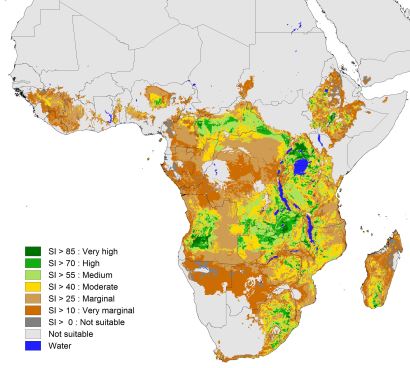Achieving sustainable agriculture
The Global Agro-ecological Zones (GAEZ) system, developed by IIASA and the UN Food and Agriculture organization (FAO), provides policymakers with comprehensive information for rational land use planning. In 2016 the system was updated and used in many countries in Asia and Africa to aid governments in improving their food security and agricultural development.
GAEZ estimates show that 70% of global water withdrawals go to agriculture and as much as 90% of fresh water use is for irrigation. Global net crop irrigation requirements will likely increase by 15-23% above 2010 levels because of climate change and expansion of irrigated areas. However, in many regions an increase of irrigation water withdrawal can be avoided or mitigated by improving the efficiency of irrigation systems and better water and land use management.
GAEZ work has resulted in collaborations around the world, including 2016 projects in Bangladesh, India, Ghana, and Thailand. In Thailand, IIASA collaborated on the project “National Agro-economic Zoning for Major Crops in Thailand,” helping to strengthen national capacity for addressing issues of land use and land planning and the sustainable management of natural resources through the establishment of agro-economic zones.
In South Africa, in collaboration with the World Wide Fund for Nature, IIASA used GAEZ to examine the potential availability of sustainable feedstock resources for producing renewable airline fuels in sub-Saharan Africa. The extended GAEZ included additional feedstock crops (including Solaris tobacco and the oil seed plants Camelina and Triticale) and assessed the potential for using them to produce airline fuels while taking into account food security requirements and environmental protection.
The latest GAEZ (version 4) includes updated information on land cover, crop areas, protected areas, renewable water resources, and climatic conditions for the historical period 1961-2010 and for a selection of future climate simulations. The FAO’s water balance and accounting model GlobeWat has also been expanded and integrated into GAEZ v4.
In 2016, work also focused on completing the preparation of the GAEZ data portal for release. The data portal will help ensure that UN member countries have sufficient, reliable information on sustainable management of natural resources for food and agriculture to support policy decisions at all scales. The portal provides free and easy internet access to data and information.
References
[1] Fischer G, Nachtergaele FO, Prieler S, Teixeira E, Toth G, van Velthuizen HT, Verelst L, & Wiberg D (2012). Global Agro-Ecological Zones (GAEZ v3.0). IIASA, Laxenburg, Austria & FAO, Rome, Italy
[2] Prieler S, Fischer G, & van Velthuizen H (2016). Land and the Food–Fuel Competition: Insights from Modeling (Chapter 29). In: Advances in Bioenergy: The Sustainability Challenge. Eds. Lund, P., Byrne, J.A., Berndes, G. & Vasolos, I., pp. 447-464 Chichester, UK: Wiley.
[3] Fischer G & van Velthuizen H (2016). National Agro-economic Zoning for Major Crops in Thailand (NAEZ v4) (Project TCP/THA/3403) – NAEZ Model Implementation and Results. Technical Report, IIASA, FAO, Laxenburg, Austria.
[4] Fan D, Ding Q, Tian Z, Sun L, & Fischer G (2016). A cross-scale model coupling approach to simulate the risk-reduction effect of natural adaptation on soybean production under climate change. Human and Ecological Risk Assessment: An International Journal: 1-15.
[5] Zhong H, Sun L, Fischer G, Tian Z, van Velthuizen h, & Liang Z (2016). Mission Impossible? Maintaining regional grain production level and recovering local groundwater table by cropping system adaptation across the North China Plain. Agricultural Water Management. Submitted.
Collaborators
- Food and Agriculture Organization of the UN
- World Wide Fund for Nature South Africa
- Institute of Rural Management Anand, India
- National institute of Hydrology, India
- Centre for Water Resources Development and Management, India
- Shanghai Climate Center, China
- University of Maryland, Department of Geography, USA


